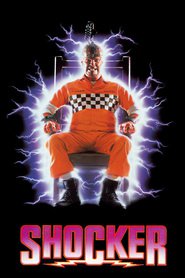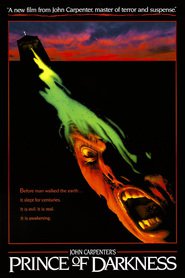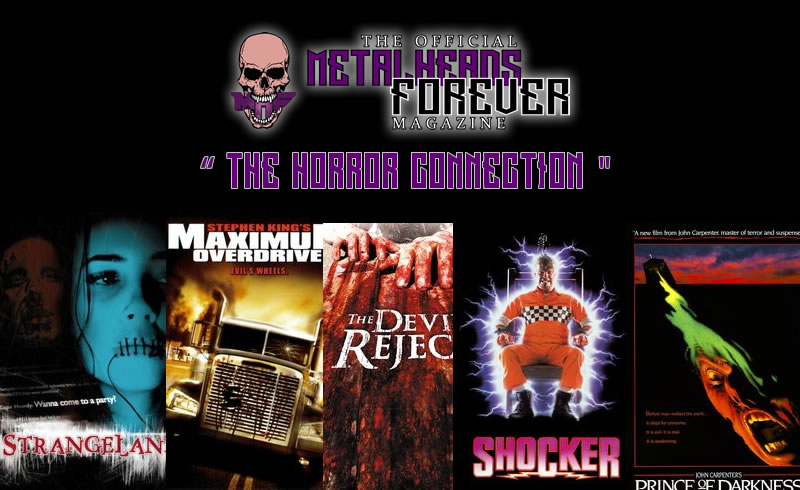 There are just two good lines in the film ”Dee Snider’s Strangeland.” One is when Robert Englund, best known as Freddy Krueger, appears in a crowd of reporters and protesters outside a supposedly rehabilitated mass murderer’s house and mutters, ”Somebody’s got to take that boy out.” The other is the mass murderer’s own comment after having been hanged (well, nearly) by a lynch mob: ”What a rush!” They don’t sound like much, but the delivery and the context help.
There are just two good lines in the film ”Dee Snider’s Strangeland.” One is when Robert Englund, best known as Freddy Krueger, appears in a crowd of reporters and protesters outside a supposedly rehabilitated mass murderer’s house and mutters, ”Somebody’s got to take that boy out.” The other is the mass murderer’s own comment after having been hanged (well, nearly) by a lynch mob: ”What a rush!” They don’t sound like much, but the delivery and the context help.
”Strangeland,” whose writer, star and co-producer is Dee Snider, lead singer of the heavy-metal band Twisted Sister, is both gruesome and boring, and that’s quite a feat.
It’s the story of one upstanding police officer and Kevin Costner look-alike, Mike Gage (played, for complete nomenclature confusion, by Kevin Gage), and his teen-age daughter, Genevieve (Linda Cardellini). Genevieve is abducted and tortured after she and her best pal accept a party invitation from a guy they met in an online chat room. Detective Gage actually finds the guy, Carleton Hendricks a k a Captain Howdy, in a dark room lined with candles and inhabited by naked torture victims with various involuntary piercings of their own.
Gage arrests Hendricks and saves Genevieve, but — darn that criminal-justice system — the jury finds Hendricks not guilty by reason of insanity and four years later he’s out on the street, cleaned up, unpierced and reportedly a completely new man. But you know better than that, and so does Gage, and the new chase continues predictably.
Everybody behaves pretty stupidly, even the murderer. There are a lot of close-ups of human body parts being pierced by large spikes. There is absolutely no tension. And the only usable moral seems to be that chat rooms are not always our friends.
– & –
 This very fun hunk of junk was horror writer extraordinaire Stephen King’s directorial debut. The film got spit on by every critic in the book upon its release and King hasn’t directed anything since. Well call me an a-hole (or an asshole) but I dug it.
This very fun hunk of junk was horror writer extraordinaire Stephen King’s directorial debut. The film got spit on by every critic in the book upon its release and King hasn’t directed anything since. Well call me an a-hole (or an asshole) but I dug it.
First off, the premise of this film is way nifty. Having machines come to life to murder us without pity and turning us into tools for their own benefit is a good idea. Don’t get me wrong, you don’t watch this flick looking for an existential study of humanity’s relationship/dependency with machines, you watch it to see people get rammed by trucks (fun stuff!) and see shit blow up real good. The film definitely delivers on that front and I really didn’t need much else to be entertained.
I can think of two scenes that have been engraved in my mind ever since I first saw the flick back in 1986. The insane car pile up on the opening bridge in the beginning of the flick and the very violent soda machine attack on a group of kids playing baseball (you don’t see a soda machine whack people every day). Those two scenes kick some serious booty and for me to remember them after all of these years can only mean one thing: the scenes are the fucking money. Thanks King.
Now if you want to be a jerk-off, you can bitch and moan about the plot holes (like why do the trucks insist on circling the truckstop instead of staying still and saving gas…then again who said the trucks were smart?) but if you actually stop for a second and think: THIS IS A MOVIE ABOUT KILLER TRUCKS THAT DRIVE BY THEMSELVES AND SQUASH PEOPLE, then maybe you’ll do the smart thing and let that shit go! Where else can you see a kid riding his bike in an empty suburb filled with dead bodies (reminded me of “The Stand”) and then eventually get chased by a lawnmower? Or a murderous truck with the face of the “Green Goblin” going ape shit? Or an electric kitchen knife slicing a poor waitress by itself? Nowhere else.
I do however, have some complaints about the film. First of all, the mid-section of the movie doesn’t fully live up to its slick set-up. It’s actually somewhat uneventful (but still watchable). Watching people wander in sewers or fill up trucks with gas for ten minutes aren’t the most exciting things in the world. On the flip side, the gas filling sequence had a kickass AC/DC song playing in the background (“Hells Bells”), which did help me digest it better. I also didn’t appreciate some of the characters. For instance, the horny bible salesman was very annoying and so was cigar-chomping Hendershot (Hingle). But the one character that I really couldn’t stand was Connie (Smith) whose high-pitched voice and constant complaining made my ears bleed. Man, did that broad get to me! I was praying for her to encounter a “Mack Truck” at a certain point but my prayers were never answered (damn!).
Overall, “Maximum Overdrive” is an amusing kitschy film. It has some good ideas, some occasional corny dialogue (that elevate the fun tacky level of the film), some really nice explosions (everything blows up…yippee!) and some nasty gory moments (when trucks hit humans, they go SPLAT!). It’s not the smartest film ever made but then again: IT’S ABOUT KILLER TRUCKS! What did people expect? An Oscar worthy monologue about technology and its pitfalls? FUCK THAT! Give me my Estevez and my “Green Goblin” rig over that any day! Who made who anyhow?
– & –
 Craven kicked himself in the ass for selling the rights to “Elm Street” and lost out on lots of money. Shocker was his attempt at creating another “killer” franchise so he could cash in. Unfortunately for him the movie tanked. But is the movie any good? It does have a great villain that would eat Freddy for breakfast. Before Horace hits the chair he’s one bad mother, with his shaved head, his great tan and his no bull attitude he’s a man you don’t want to mess with.
Craven kicked himself in the ass for selling the rights to “Elm Street” and lost out on lots of money. Shocker was his attempt at creating another “killer” franchise so he could cash in. Unfortunately for him the movie tanked. But is the movie any good? It does have a great villain that would eat Freddy for breakfast. Before Horace hits the chair he’s one bad mother, with his shaved head, his great tan and his no bull attitude he’s a man you don’t want to mess with.
The movie has fun visual effects (specially the TV traveling finale) and a few good ideas (Horace jumping from body to body shamelessly copied in the movie “Fallen”). Unfortunately the movie is plagued by a very weak script with horrendous dialogue, dream sequences that are not needed, a love conquers all attitude (corny) and a ridiculous way of defeating the shock boy. Once Pinker comes back from the dead, he becomes a wise cracking, supernatural clown that doesn’t scare you anymore but makes you laugh instead…Craven goes “Elm Street” on steroids. Instead of trying to give “Elm Street” a bigger, badder brother he should have followed through with the dark, chilly tone he sets up in the first fifteen minutes and make an original movie.
With that said, the whole thing works as a well shot, rock and roll, fun cheese horror flick with lots of jokes, cool heavy metal tunes, funny one liners and Horace Pinker rocking the house! Lets fry this one…
– & –
 From the start, Rob Zombie was more a multimedia happening than a rock star. Sure, the music was rousing, but it was the total package that put it over. A pop-culture scholar with a macabre bent, Zombie knows how to mix and match elements to his own ends, creating videos that dropped him in the middle of a German Expressionist nightmare, artwork that crossed Ed “Big Daddy” Roth with the pages of Famous Monsters Of Filmland, and an image that’s part late-night horror host, part Charles Manson cultist. Scraggly beard, demonic eyes and all, Zombie has never been less than a craftsman at whatever he chose to do, and that included his feature-film debut, House Of 1000 Corpses.
From the start, Rob Zombie was more a multimedia happening than a rock star. Sure, the music was rousing, but it was the total package that put it over. A pop-culture scholar with a macabre bent, Zombie knows how to mix and match elements to his own ends, creating videos that dropped him in the middle of a German Expressionist nightmare, artwork that crossed Ed “Big Daddy” Roth with the pages of Famous Monsters Of Filmland, and an image that’s part late-night horror host, part Charles Manson cultist. Scraggly beard, demonic eyes and all, Zombie has never been less than a craftsman at whatever he chose to do, and that included his feature-film debut, House Of 1000 Corpses.
A technically expert, meticulously designed homage to ’70s grindhouse cinema,Corpses let Zombie direct horror-movie scenes that he must have been wanting to try for years, and he produced some unforgettable moments in the process. No one knows how to draw out the sinister undercurrents of a Slim Whitman song quite so well. Unfortunately, Corpses turned into overkill, both in the figurative and literal senses. As the body count mounted, the scares began to wear off, and the film started to look more like an exercise in joyless retro-appreciation than like its own film.
The Devil’s Rejects picks up where Corpses left off and eventually runs into the same problems, but it first confirms Zombie as an estimable director, regardless of genre or other occupations. Returning to Corpses’ 1970s-era back roads, it follows Corpses’ family of sadistic murderers as they attempt to elude tough-talking lawman William Forsythe. Sid Haig, a cult figure best known for his role in Spider Baby, leads the clan as Captain Spaulding, a gas-station/roadside freak-show owner who goes on the lam with thrill-killers Sheri Moon Zombie and Bill Moseley. Their flight takes them from a rundown tropical-themed motel—where they terrorize a traveling band of country musicians led by Geoffrey Lewis—to a sleazier-than-usual whorehouse.
Zombie fills The Devil’s Rejects with thrilling set pieces, pays homage to his inspirations without outright ripping them off (most of the time), brings back some cult-movie icons (hello, Mary Woronov and E.G. Daily), and works in some profanely clever dialogue: Anyone wondering about the logistics of chicken-fucking or the marketing problems of a robot-themed brothel won’t be disappointed. It’s an audacious piece of filmmaking, but after a while it grows exhausting to watch, particularly when it becomes clear that violence is going to lead to more violence without much story or conscience surfacing. Rejects might, in its way, be the perfect horror film for a moment when endless cycles of revenge have become institutionalized as global politics, but in the end, it’s hard to walk away unnumbed by so much blood and so many unanswered screams.
– & –
 John Carpenter’s Prince of Darkness is one of the creepiest movies ever made. Underrated at the time by critics who called it “cheesy” (Vincent Canby)1 and said “[it] stinks” (Richard Harrington), Prince of Darkness was clearly made fast and on the cheap, and it’s roughly-crafted by Carpenter standards. Still, it’s a triumph of mood. Filling out a mystery-of-the-ancient-artifact yarn with a cosmic-horror mythology, Prince of Darkness lives in a sweet spot between religious thriller and Satanic potboiler where science is the way, the truth, and the life, for better or worse.
John Carpenter’s Prince of Darkness is one of the creepiest movies ever made. Underrated at the time by critics who called it “cheesy” (Vincent Canby)1 and said “[it] stinks” (Richard Harrington), Prince of Darkness was clearly made fast and on the cheap, and it’s roughly-crafted by Carpenter standards. Still, it’s a triumph of mood. Filling out a mystery-of-the-ancient-artifact yarn with a cosmic-horror mythology, Prince of Darkness lives in a sweet spot between religious thriller and Satanic potboiler where science is the way, the truth, and the life, for better or worse.
When the last member of the Brotherhood dies, a curious priest named Father Loomis (Donald Pleasence) implores USC quantum physics professor Edward Birack (Victor Wong) to make sense of the strange canister. Birack recruits a small army of students to give up their weekend and live inside the church, using a battery of computer equipment to monitor and analyze the object. What they discover is a series of impossibilities. A 2,000-year-old manuscript includes differential equations in the original Latin. The corrosion on the outside of the canister dates back 7 million years. And, perhaps most disconcertingly, the artifact’s elaborate mechanical seal is securely locked. From the inside. Meanwhile, a group of zombified homeless men and women (led by a stone-faced Alice Cooper) is preventing anyone from leaving the churchyard alive.
What’s remarkable about the unfolding mystery of Prince of Darkness is not just that the characters are so determined to rely on scientific inquiry in the face of an apparently inexplicable menace. After all, that’s fodder for any number of supernatural horror movies predicated on the failure of medicine and physical science to explain or properly address demonic possession, re-animated corpses, the birth of the Antichrist, etc. But these kids (like the scientists in John Carpenter’s The Thing, for example) are actually successful in using their brains to suss out what’s going on.
Carpenter’s approach to this stuff is inspired partly by a broad-strokes interpretation of Christianity, but also by some reading on quantum mechanics. Ideas about matter and anti-matter inspired him to wonder: what if Christianity got it only partially right? What if God actually exists, but in a mirror-image version? More to the point, what if the omnipotent God isn’t a good guy? One of the assembled grad students, Lisa (Ann Yen), is assigned to decode from the original Latin a previously-untranslated palimpsest that is, oddly, full of numbers. It tells the story of an old-timey god who lived on Earth before human life arose and was somehow banished to a dark, negative universe–but not before burying that freaky canister somewhere in the Middle East. “Maybe he’s Anti-God,” muses Birack, “bringing darkness instead of light.” The canister contains the Anti-God’s son, giving the film its title. The document reveals that Christ was an alien visitor who came to warn humans of the danger the canister posed: that the Prince would eventually find a way to bring his father back from the dark realm. Helpless to deal with the threat, the Brotherhood took notes on the incomprehensible science of the thing, then developed metaphors for evil that would keep Christianity strong until mankind developed the mathematical skills to make sense of the calculus and banish the Anti-God forever.



